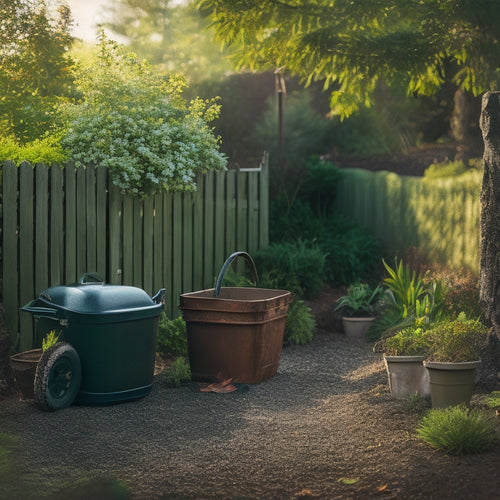
3 Best Automated Rainwater Systems for Sustainable Homes
Share
You're considering investing in an automated rainwater system to support your sustainable home goals. You'll want to investigate top solutions that conserve water resources while minimizing maintenance and energy consumption. Gravity-fed systems with advanced filtration are favored for their simplicity and low maintenance. Automated water distribution solutions optimize efficiency, reduce potable water usage, and energy consumption. Smart features like real-time monitoring, alerts, and eco-friendly technology further enhance resource management. For an extensive look at the top 3 automated rainwater systems that can help you achieve sustainable home goals, investigate further to find the perfect fit for your needs.
Key Takeaways
- Automated rainwater systems optimize efficiency, reducing potable water usage and energy consumption for sustainable homes.
- Gravity-fed systems with advanced filtration ensure high-quality rainwater for non-potable uses, such as irrigation and toilet flushing.
- Real-time monitoring and alerts enable homeowners to track water usage, storage levels, and maintenance requirements for optimal management.
- Integration with renewable energy solutions and eco-friendly technology minimizes waste and carbon footprint in sustainable homes.
- Smart distribution systems streamline maintenance, enabling whole-house applications and supporting self-sufficiency in sustainable living.
Top Rainwater Harvesting Systems
Frequently, homeowners seeking to incorporate sustainable practices into their daily lives turn to rainwater harvesting systems as a reliable means of conserving this precious resource.
You can choose from a range of top rainwater harvesting systems, each designed to meet specific needs and budgets. Many eco-friendly charging stations, such as those powered by solar panels, also incorporate rainwater harvesting systems to minimize their environmental footprint.
Gravity-fed systems are popular for their simplicity and low maintenance, while more complex systems incorporate advanced filtration systems to remove impurities and contaminants.
When selecting a system, consider factors such as roof size, water storage capacity, and intended use. Look for systems that are durable, easy to install, and adaptable to your local climate.
Automated Water Distribution Solutions
You can optimize your rainwater harvesting system's efficiency with automated water distribution solutions. These solutions enable you to manage and allocate rainwater effectively, reducing waste and ensuring a consistent supply for your sustainable home. Automated irrigation systems, for instance, can distribute rainwater directly to your garden or lawn, reducing the need for potable water. Rainwater filtration systems can also be integrated to remove impurities and contaminants, making the water suitable for various non-potable uses.
| System Type | Benefits | Applications |
|---|---|---|
| Automated Irrigation | Reduces potable water usage, saves energy | Garden, lawn, agricultural irrigation |
| Rainwater Filtration | Removes impurities, contaminants, and sediment | Toilet flushing, washing machines, cleaning |
| Smart Distribution | Optimizes water allocation, reduces waste | Whole-house water distribution, fire suppression systems |
Smart Rainwater Management Features
By integrating smart rainwater management features into your automated rainwater harvesting system, you can take efficiency to the next level.
With smart monitoring, you'll be able to track your water usage and storage levels in real-time, receiving alerts when the tank is full or when maintenance is required. This eco-friendly technology optimizes water distribution, reducing waste and ensuring you're making the most of this precious resource.
By leveraging renewable energy solutions, you can further reduce your carbon footprint and create a more sustainable home. Additionally, incorporating energy storage systems can provide backup power during outages, enhancing grid resiliency.
You'll also be able to automate tasks, such as flushing gutters and downspouts, and receive notifications when there's an issue. By streamlining your rainwater management, you'll save time, reduce your environmental footprint, and enjoy the freedom that comes with a sustainable, self-sufficient home.
Frequently Asked Questions
Can I Install an Automated Rainwater System Myself or Do I Need a Pro?
As you ponder tackling the project solo, consider this: while DIY installation is possible, correctly configuring system components like sensors, pumps, and valves requires knowledge, so it's wise to consult a pro to guarantee a seamless, efficient setup.
Are Rainwater Harvesting Systems Suitable for Areas With Low Rainfall?
You're wondering if rainwater harvesting systems work in areas with low rainfall. Yes, they can, especially with smart rainwater storage design, ensuring drought resilience by collecting and storing every precious drop for non-potable uses, like flushing toilets and washing machines.
How Often Should I Clean and Maintain My Rainwater Harvesting System?
As you tend to your rainwater harvesting system, remember it's like nurturing a garden - regular care guarantees a bountiful harvest. Clean your system every 3-6 months, and perform routine maintenance tasks, like inspecting gutters and downspouts, to keep it flowing freely.
Can I Use Rainwater for Drinking, Cooking, and Personal Hygiene?
You can use rainwater for drinking, cooking, and personal hygiene, but only if you guarantee high water quality through effective filtration methods, such as UV treatment, sedimentation, and activated carbon filtration, to remove contaminants and pathogens.
Are There Any Government Incentives for Installing Rainwater Harvesting Systems?
Freedom from financial burdens, you ask? Well, you're in luck! You can tap into government rebates and tax credits for installing rainwater harvesting systems, offsetting the initial investment and making sustainable living more accessible.
Related Posts
-

Why Choose Cool Roofs in Scorching Climates?
You opt for cool roofs in scorching climates because they enable you to reclaim control over your energy consumption ...
-

7 Best Automated Sprinklers for Water-Wise Green Homes
You're likely among the 75% of U.S. homeowners who use in-ground sprinkler systems, and coincidentally, you're also c...
-

10 Green Waste Solutions Every Homeowner Should Know
You can make a significant impact on the environment by implementing green waste solutions at home. Consider composti...


